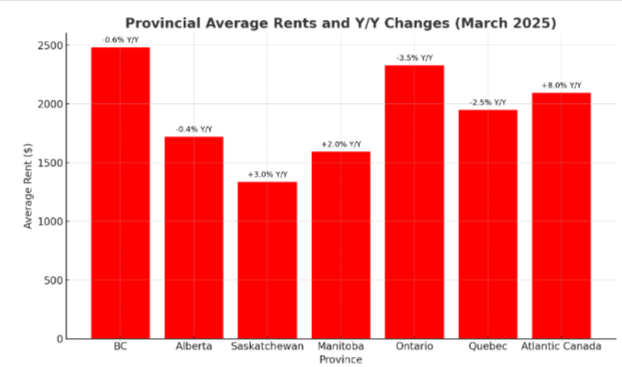
In March 2025, average asking rents in Canada rose by 1.5% compared with February, marking the first monthly increase since September 2024. Despite this rebound, however, rents were still 2.8% below their level of one year earlier, stretching the year‑over‑year decline to six consecutive months.
These trends were observed in Rentals.ca’s April Rent Report, which also noted that record levels of new completions continued to keep supply elevated, tempering overall rent growth.
Average Rents
Overall average asking rent across all property types remains 17.8 % higher than in March 2020. Purpose‑built apartments rose 35.5 % over the same period, and commanded an average rent of $2,086 in March. Condominium rentals averaged $2,232, down 3.8% over the past year but still slightly above pre‑pandemic levels. House and townhouse rentals averaged $2,186, a 5.6% drop year‑over‑year, but 13.6% higher than five years ago.
Historically, since March 2020, average asking rents in Canada have climbed by 17.8%. Purpose‑built apartments led this growth with a 35.5% increase, dwarfing the 0.6% rise in condo rents and the 13.6% gain for houses and townhouses. The largest purpose‑built units saw the most significant increases: three‑bedroom rents soared by 39.6% over five years, while two‑bedroom rents rose by 38.4%. One‑bedrooms and studios also enjoyed strong gains of 35.3% and 34.2%, respectively.
Within purpose‑built stock, studios and three‑bedroom units outperformed smaller layouts: studio rents increased by 1.8% to $1,593, and three‑bedroom rents climbed by 3.7% to $2,711. In contrast, one‑ and two‑bedroom purpose‑built apartments both saw their rents decline by 2.2%, averaging $1,883 and $2,280, respectively. Among condos, three‑bedroom units rose by 1.0% to $2,850, while two‑bedroom rents fell by 4.3% to $2,374. One‑bedroom and studio condo rents also edged lower, declining by 3.7% and 1.4% to $2,032 and $1,826, respectively.
Source: Rentals.ca
Provincial Trends: Prairies and Nova Scotia Show Strength
At the provincial level, combined average rents for apartments fell by 1.9% to $2,101 in March. Ontario experienced the steepest annual decrease, with rents dropping by 3.5% to $2,327, followed by Quebec, where rents declined by 2.5% to $1,949. British Columbia and Alberta saw smaller decreases of 0.6% and 0.4%, bringing their averages to $2,480 and $1,721, respectively. Conversely, Saskatchewan, Manitoba and Nova Scotia posted annual rent gains of 3.0%, 2.0% and 2.4%, reaching $1,336, $1,592 and $2,199.
Three-Bedroom Rents Rise Across Canada
Three‑bedroom rents bucked the trends, and increased in every province: they rose by 1.9% in B.C. to $3,427; by 5.6% in Alberta to $2,169; by 5.1% in Saskatchewan to $1,716; by 0.1% in Ontario to $3,019; and by 4.4% in Quebec to $2,630.
Purpose-Built Apartment Growth
Over the five‑year period, purpose‑built rents increased most rapidly in Nova Scotia—up 43.9%—and in Alberta, where they grew by 38.5%. British Columbia and Saskatchewan recorded gains of 36.9% and 33.9%, respectively; Ontario’s five‑year increase lagged at 16.4%.






